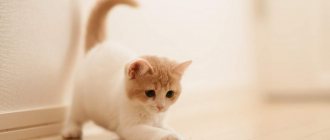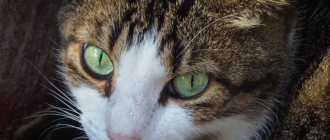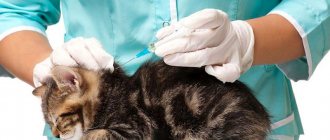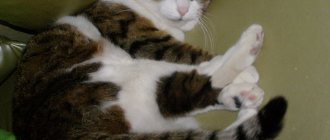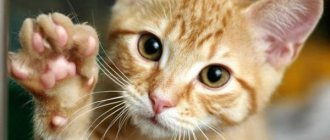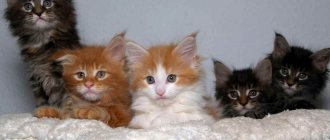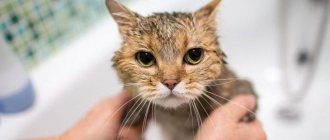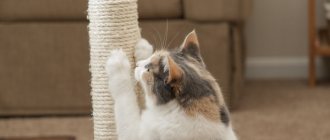Signs and main causes of constipation
Constipation is manifested by the following symptoms:
- no stool for more than 3 days;
- there is little stool and it is very dry;
- the cat sits on the tray for a long time, pushing, but to no avail;
- visits to the toilet are painful for the animal;
- flatulence;
- anxiety;
- the anus is swollen.
The causes of constipation are various:
- Most often, constipation is caused by improper nutrition (excess protein, lack of fiber, in kittens - switching to a different diet), stress, or the formation of a hairball, because the cat constantly licks itself. A newborn kitten cannot poop on its own. The cat licks his tummy, anal area and provokes the process of defecation. If a mother does not take care of her newborn children, they will have problems with bowel movements.
- Less common, but more dangerous causes are internal diseases, tumors and hernias in the intestine, deformation of the colon or rectum, and previous injuries (fractures).
- The most serious case when a cat does not pass feces is a volvulus or a foreign body entering the intestines.
An enema for a cat is an acceptable method of treating constipation only if it is caused by reasons related to improperly selected food or the formation of a hairball. If there are internal diseases or intestinal blockage, an enema is deadly. Therefore, a doctor should make a diagnosis and recommend treatment after examination.
Prevention of fecal impaction
To avoid excesses with difficulty defecating, try to follow the following recommendations:
- Provide your pet with a balanced diet, do not allow sudden changes in the diet, do not treat the fluffy with delicacies from the master’s table (smoked meats, pastries, sausages);
- avoid purchasing cheap dry food, choose a super premium option;
- Make sure your pet has enough fluids;
- To prevent constipation from occurring in old cats, examine them regularly and treat them promptly; once a year, with the “blessing of the veterinarian,” you can take a preventive course of Dufelax;
- To remove hair that enters the animal’s body, it is recommended to give it a special paste.
If your pet is well cared for, problems with bowel movements will be rare. The owner of a meowing creature needs to understand that hard stools can be a manifestation of a serious illness.
Not all cat problems can be solved with Vaseline oil or an enema. These are first aid products for home use. This should be followed by a visit to the clinic, examination and elimination of the cause of the intestinal problems.
Don't forget to click Class! CoolTweetSharePlusShareSendWhatsAppPinBack
When to do an enema
If there is no opportunity to see a doctor, the case of constipation has arisen for the first time, and there are no symptoms of other diseases, then before giving the cat an enema, the first thing to start with is changing the diet and trying to eliminate constipation by massaging the cat’s abdomen. This is an effective method that is suitable for adult cats and kittens.
If the massage has no effect, you can give the cat Vaseline oil. The oil is poured into the mouth with a syringe. For an adult cat, approximately 20 ml of Vaseline oil per day is calculated. You need to act carefully. If the oil gets into the lungs, it can cause swelling and result in the death of the animal.
When is a doctor needed?
It is better to take the kitten to the veterinarian as soon as symptoms of the pathology appear. The need for an enema should be determined by a specialist; sometimes such a measure will be useless and even dangerous. If there is a suspicion that the cat has swallowed a foreign object that could be stuck in the intestines, it is necessary to show the pet to a doctor, since in some cases the only treatment option is surgical removal of the stuck body.
You will have to contact a veterinarian if there are contraindications to the use of enemas. In addition, you will have to go to the veterinary clinic if the procedure does not bring the desired effect. If the owners do not know how to give an enema, it is also better to contact a specialist.
Contraindications
Enema - as a means of combating constipation is contraindicated in the following cases:
- tumors in the intestines;
- inflammatory process in the gastrointestinal tract;
- volvulus, acute obstruction;
- foreign body in the digestive tract (usually bone);
- pregnancy.
An enema is contraindicated for a cat if feces are excreted in small quantities and are black in color. This is a sign of internal bleeding in the upper digestive tract.
What causes constipation in cats
Constipation in cats can be caused by a variety of factors, including:
- unbalanced diet;
- disruption of metabolism and endocrine processes in the body;
- incorrectly selected food;
- oncological pathologies;
- the presence of a foreign body in the intestine;
- chronic pathologies of the liver, gastrointestinal tract;
- inflammation of the paraanal and anal glands;
- anatomically narrow anus;
- disruption of digestive processes.
As a rule, problems with defecation are noted in older cats. At the same time, males are more prone to constipation than females, which is due to anatomical features.
Important! The symptoms of periodic constipation are very similar to the symptoms of urolithiasis (urolithiasis).
In addition, it is worth noting that constipation itself is not a separate pathology, but rather a symptom that indicates functional, systemic disorders in the body of furry pets.
What is needed to perform an enema?
It is difficult for one person to give an enema to a cat at home. Need an assistant. Not a single cat will voluntarily agree to such a procedure.
To carry out you will need:
- A bulb (syringe), preferably with a rubber tip. The plastic nozzle can seriously injure your cat's anus if he resists, which he will. The volume of the pear depends on age. A 300 ml syringe is suitable for a large adult cat, and 150-200 ml for a kitten.
- The bulb can be replaced by a drip hose and a syringe. The hose has a small diameter and is much easier to insert into the cat's anus. The liquid is supplied into the tube with a large syringe without a needle.
- If you need to give a kitten an enema, you can use a pipette.
- Solution for administration (prepared independently or from a pharmacy).
- Lubrication. Vaseline, vegetable oil or baby cream are used as a lubricant.
- Rubber gloves, basin.
Types and required solution
If the pet is still small, then a syringe is suitable for the procedure.
In veterinary practice, there are two types of enema. It can be medicinal and cleansing. If we are talking about the latter, then it is prescribed to eliminate feces from the intestines. The solutions used during the manipulation process dilute feces, improve peristalsis and remove feces. A medicinal procedure is required to introduce medications into the large intestine for the purpose of local treatment. This enema is mainly used if the cat is diagnosed with inflammatory diseases of the gastrointestinal tract. If we talk about devices for an enema, then you can do it at home for newborn kittens with a syringe. It is recommended that older animals receive an enema using a bulb with a rubber tip, which can be purchased at pharmacy chains. A procedure using water and Vaseline oil will help cleanse the intestines. The volume of the first component is 100 ml, the second ingredient will need to take 2 tablespoons. It is better to pre-heat the oil in a water bath, which will give the maximum effect of the manipulation. A procedure with medicinal chamomile, which has anti-inflammatory properties and effectively fights parasites, can also be prescribed. To prepare the product, you will need to take 150 ml of water, 2 tablespoons of chamomile flowers and boil the composition.
Enema technique
The cleaning procedure is carried out according to the following scheme:
- The pear is filled with the prepared solution. To do this, you need to squeeze it, lower the tip of the syringe into the solution and gradually release the pressure on the walls. For one procedure you need to take 50-100 ml of solution.
- It is recommended that the assistant place the cat on one arm and hold the paws with the other. If the pet is flexible, then it is more convenient for the owner to place the pet on his left hand. You may have to give the cat a sedative. It's difficult to cope without him.
- Lubricate the tip of the bulb with lubricant and release any air from the syringe.
- Slowly and carefully insert the tip into the anus. The direction is parallel to the spine. It is advisable to first make marks on the nozzle - 1 and 2 cm. For adult cats, the tip is inserted to a depth of 2 cm, for kittens - 1 cm. If the tip does not fit, you cannot press. You need to stop and introduce as much liquid as possible. For a 1-2 month old kitten, it is enough to administer 2-3 pipettes of solution. Abdominal massage will speed up bowel movements.
- After introducing the liquid, the tip of the syringe is carefully removed. You need to press the cat's tail to the anus and hold it with your finger.
To avoid damaging the colon, the solution is administered very slowly. Rapid application of the solution will cause discomfort in the pet and will not soften the stool.
You can allow your pet to go to the toilet directly into the basin.
If blood is found in the stool after an enema, urgent consultation with a veterinarian is required. Blood in feces is a sign of internal disease.
Recommendations for preparing for an enema
How to brush a cat's teeth: options at home
To carry out the manipulation correctly, it is necessary to properly prepare.
Note! It is highly undesirable to use bulbs, syringes and ready-made cleaning compositions intended for people. The best enema for a cat is purchased at a special veterinary pharmacy.
Unlike human ones, it does not contain phosphates, which are harmful to animals. These enemas may contain sodium dioctyl sulfocynate, which softens fecal matter, and glycerin, which lubricates the small intestine from the inside.
The procedure is also performed with a special syringe, the thin tip of which is lubricated with ordinary Vaseline cream or other lubricant. This is a prerequisite for the most painless procedure, which is unpleasant for the animal. The two-cc syringe works well for a warm mineral oil enema because it contains a urethral catheter that acts as an applicator. It has soft edges that will not irritate or injure a sick cat.
Enema procedures are best carried out in a small room where there is access to water. The bathroom is ideal; you need to place a familiar cat tray with your favorite filler or a basin in it, and it is better to close the door to the room during the procedure.
Important! For safety and sterility, it is recommended to wear rubber gloves
Enema solutions
An enema for a cat with constipation is done with the following solutions:
- Salt based. Dissolve 1 teaspoon of sea salt in 250 ml of water and heat until completely dissolved.
- A solution with baby soap, not very concentrated. The product works effectively, but cannot be used often - it has an irritating effect on the rectum.
- Tap water. Plain water can soften stool and promote its passage.
- Vaseline oil. Use in pure form or add a few drops to water. The oil coats the stool and lubricates the intestinal walls, making it easier for feces to pass through the digestive tract. 5-10 ml of oil is enough for an adult cat and 1 ml if you need to give an enema to a kitten.
- Chamomile decoction. The infusion is made at the rate of a tablespoon of dry chamomile per 200-300 ml of boiling water. The liquid is allowed to brew for 15 minutes, then filtered, cooled to a comfortable temperature and injected using a pear.
A prerequisite is that any solution for rectal administration should not be hot or very cold. The optimal temperature is 25-30 degrees.
It is recommended to resort to traditional methods of treatment if there are no medications in the house, such as microenemas, and there is no opportunity to buy them.
The feasibility of enema
Typically, animals require assistance with forced bowel movements if they have not had stool for 3-4 days. This condition is called mild constipation. The reason for the lazy functioning of the digestive organs usually lies in an incorrect diet, namely a low fiber content. Another situation is the entry of foreign objects into the colon or illness.
Indications for use
An enema for a cat is prescribed strictly after examination by a veterinarian - self-medication can cause complications or even death. You cannot administer an enema to your pet on your own.
Main indications for performing an enema:
- chronic type of stagnation;
- poisoning of the body;
- inflammation of the gastrointestinal tract.
The first forced cleansing is best done in a veterinary hospital under the supervision of a specialist. In the future, you can give a cat an enema for constipation at home, but in compliance with all the doctor’s recommendations. He will tell you whether it is possible to give a cat an enema, and recommend a specific solution and volumes.
Permitted procedure frequency
Artificial bowel movement should be carried out as rarely as possible - so that the muscles of the organ do not lose tone, and in the future constipation does not become a constant problem. The maximum frequency is twice a week and provided that the cat cannot go to the toilet on its own.
Usually the veterinarian prescribes a one-time procedure and looks at the result. If it is not there, then the manipulation is repeated. If there is no stool after a double enema, the pet is given help of a different nature.
When not to do an enema
The issue of purification should not be decided on your own. A mandatory consultation with a veterinarian is required, who, after collecting all the tests and examining the patient, gives a prescription. Cleansing does not always help - on the contrary, there are situations when it is strictly contraindicated:
- pregnancy at any stage;
- injuries to internal organs or anus;
- obstruction;
- severe foci of inflammation in the colon;
- tumors/formations, malignant or benign;
- bleeding of various types;
- disorders of the cardiovascular system;
- bacterial or viral diseases.
As a rule, contraindications are violations hidden from the public eye. This is why it is highly recommended to visit a veterinarian before giving your cat an enema.
Pharmacy enemas
Using a syringe, tube and syringe is a complex process to perform. It is also important not to overfill the liquid. Without experience and knowledge, this is not easy to do. Therefore, it is better to start with pharmaceutical products. You can do enemas with solutions of lactulose-based medications, for example, Duphalac. Suitable for cats: Microlax and Proctum.
The most popular option is Microlax microenema. For an adult cat, it is enough to inject half the tube. To do this, remove the cap and lightly push the liquid towards the tip of the applicator to lubricate the tip. Then the applicator is smoothly inserted into the anus about 1.5 cm. You need to press hard on the tube, as it is quite hard. The microenema takes effect within 5-10 minutes. If there is no result, then the second half of the product is administered after 3 hours.
The Microlax tip is too large for a kitten, so the suspension is administered to the baby using an insulin syringe (1 ml). Half a syringe is enough.
Dosage of the drug and method of administration
Microlax microclysters are intended for people, so you will not find instructions on the dosage of the drug for animals in the instructions. You will need to independently determine the dose of the drug. The dosage of Microlax for a cat depends on the age of the animal, its size and the characteristics of a particular clinical case:
- If we are talking about an adult animal weighing 3-5 kg, then you need to use the dose intended for children (half a tube).
- The drug can also be used to treat kittens. It is not recommended to use Microlax for newborn babies. The kitten must weigh 300 grams or more. The dosage is 0.2-0.4 ml. It is better to use a syringe for this.
shutterstock
Cats have an extremely negative attitude towards enemas. This is a lot of stress for the animal.
During the procedure, it is important to minimize the impact of this negative factor on the animal. Try to console the cat and talk to it
The owner's support is very important for the animal!
It is best to have 2 people give the cat an enema. It is very difficult to carry out such a procedure correctly alone: the cat will try to break free and run away, or even bite and scratch.
A pressing question for many owners is: “Is it possible to use Microlax to treat sterilized cats?” Unfortunately, there is no clear answer to this question, since the effect of the drug on cats has not been studied. There is a possibility that the artificial pushing caused by the medication may harm a cat that has previously been spayed. Based on these considerations, it is not advisable to give Microlax to a cat after sterilization. However, in any case, the last word remains with the specialist. Only the doctor should decide which remedy to use to treat the cat.
Preventing constipation
To reduce the number of digestive tract problems in cats, you should pay attention to simple preventive measures. For example, timely grooming will eliminate the formation of hairballs inside the stomach
They can obstruct the passage of feces by accumulating in the gastrointestinal tract. To avoid such trouble, use pastes and phytomines. Well, cats who spend time outdoors cope with this problem themselves: they eat grass, which causes vomiting and eruption of hairballs.
Physical activity plays an important role in preventing chronic constipation. The yard individual runs around the street day and night, but the furry homebody, who does not have access to the street, spends most of his time on the sofa or bed. He moves little, usually eats a lot and is often obese. The owner must keep the cat in good physical shape with the help of animal toys, special exercise equipment and entertainment houses.
It is worth including fiber in your diet: it helps cleanse the body of stagnation and accumulation of feces. If an animal consumes dry industrial food, it must be of the highest quality. Premium canned goods solve the problem of peristalsis well, but do not always guarantee good digestion.
The cat's natural food should be enriched with vitamin and mineral complexes. Low-fat milk products: kefir or cottage cheese should appear regularly in the diet. Pumpkin puree soups with the addition of a small amount of vegetable oil are very useful for pets suffering from sluggish peristalsis.
It is important to provide the cat with access to clean drinking water - it has an effect on the dilution of feces and promotes their better excretion
Enema of a cat at home is allowed only as prescribed by a doctor. He will help determine which solution is best for your pet, suggest an algorithm of actions, and prescribe the frequency and dosage. Forced bowel cleansing has contraindications and is therefore used only after determining the cause of constipation. Prevention involves adjusting the diet, establishing the correct drinking regime and adequate physical activity.
The article is for informational purposes only. Contact your veterinarian!
Instructions for the procedure
The enema should be done exclusively on an empty stomach, after giving the pet a dose of a moderate sedative. It is better to consult your veterinarian in advance about the name of the drug. After preparing the cat, collect everything you need for the procedure and proceed with it. It is advisable that you have a reliable assistant who will hold the animal during the enema. The cat will not be given voluntarily; you cannot cope alone.
What is needed for the planned event
For the cat, prepare a towel or rag in which you will wrap his legs so that he does not jerk them during the enema and knock the bulb out of his hands or damage his rectum during the administration of the solution due to sudden movements.
The procedure itself requires the following elements:
- Rubber bulb. It is better if the tip is also made of rubber. Plastic can severely damage a cat's rectum, especially if he actively resists. You need to select the volume at the rate of 300 ml for an adult and 200 ml for a kitten;
- Solution for rectal administration (composition will be described below);
- Lubricant (lubricant). Available means can be used: baby cream, any vegetable oil, Vaseline;
- Additional components: a thermometer for measuring the temperature of the prepared solution (it should not exceed 30 degrees Celsius), unnecessary rags, sterile rubber gloves (these can be purchased at any pharmacy), a large basin in which the procedure will be carried out (it will also replace the tray).
Table. Composition of solutions for rectal administration
| Solution | Compound | Cooking method |
| Solyanoy | 1 tbsp. l. sea salt, 300 ml water | The salt is dissolved in heated water and introduced freshly prepared into the rectum. |
| Chamomile decoction | 1 tbsp. l. dried chamomile flowers, 200 (300) ml of water. | Dry raw materials are poured with boiling water in the specified volume, infused for 15 minutes, and drained. The solution cools to the required temperature and is administered rectally using a bulb. |
| With lemon juice | 1 tsp. lemon juice, 300 ml water. | The ingredients are mixed, the water is heated and administered rectally to the pet using a bulb. |
| With vinegar | 0.5 tsp. apple cider vinegar, 300 ml water | The ingredients are mixed, heated and injected into the rectum. |
| With Vaseline oil | 2 tbsp. l. Vaseline oil, 300 ml of water. | The oil is heated and mixed with water in its already heated form. The emulsion is injected into the rectum. |
| With glycerin | 5 drops of glycerin, 300 ml of water. | Glycerin is added to heated water, and the solution is administered rectally. |
You can watch the video for more details on how to administer a microenema:
Enema technique
After you have prepared everything, boil the pear and let it cool. Afterwards, squeeze it and lower the nose into the prepared solution, “suck” with the bulb as much as will fit inside it. At this time, the assistant should take the cat and put it on his left hand, holding its right paw to ensure that the procedure is as comfortable as possible for you. The pet must be held over a prepared basin.
Enema technique
When the cat has taken the desired position, take the pear in your right hand, lightly press on it so that a few drops of liquid come out (this is necessary to get rid of stagnant air inside it). Lubricate the rubber tip generously with lubricant and insert it into the pet’s rectum to a depth of no more than 2 cm. If you are giving an enema to a kitten, then no more than 1 cm. It is advisable to make a mark on the tip of the device before the event.
When penetrating the rectum, try to stay in the direction “parallel to the spine”, this is how the cat’s intestines are located
Inject the solution carefully and slowly. If you have the slightest difficulty during insertion, stop the procedure; you can seriously damage the animal’s colon
The same applies to inserting the tip of the enema. If you feel that further advancement is impossible, do not press, but try to carefully introduce the permissible amount of liquid.
Administration of an enema in a veterinary hospital
After administering the solution, carefully remove the enema and press the cat's tail to its anus with your finger. This is necessary for the full effect of the fluid in the rectum, softening the stool and facilitating their removal out. Try to control your cat's urge to defecate for 10-15 minutes. Then let her defecate directly in the basin. If blood appears during stool removal, you should call a veterinarian as soon as possible. This is a signal of a serious disorder in the animal’s body.
General information
Constipation is a pathological condition in which feces in the large intestine of an animal are not excreted into the external environment, but remain in the lumen of the organ. There they are “rammed”, compacted, and the body sucks out all or almost all the moisture from them. In addition, “old” feces are a constant source of strong toxins that are continuously absorbed into the blood and poison the animal’s body. The intoxication that appears as a result of this process can be so strong that with chronic constipation, a cat can vomit foamy masses, and the likelihood of developing kidney and heart failure increases by more than 70%.
Finally, “petrified” feces are so hard that they can mechanically damage the intestinal walls. Because of this, a sick cat is likely to develop sepsis, since the damaged mucous membranes of the organ can no longer prevent the penetration of pathogenic and conditionally pathogenic microflora into the general bloodstream.
Note that constipation is not a unique pathology at all, and it can also occur in animals that have not previously suffered from digestive disorders. Particular problems arise for owners who have several animals living in their house: it can be difficult to find out which cat has developed constipation.
But there is one trick - you can feed the cats (alternately) beet-based baby food. This product is capable of coloring feces in a specific, easily recognizable color. Please note that as a result of its use, not only the feces, but also the animal’s urine will acquire a reddish tint. Thus, given the special color of the feces, you can easily determine which of your pets the dry feces belong to. If a cat fed with beets does not defecate at all, you will also quickly find out about this.
